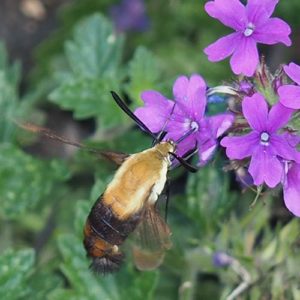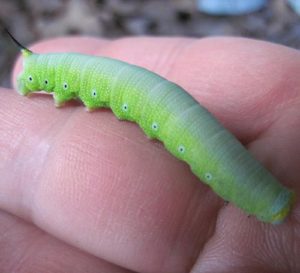Have you ever caught a quick glimpse of a tiny “hummingbird” hovering around a flower? Then realized that not only was it too small, but it also wasn’t the right colors and wasn’t producing the characteristic hum. Perhaps it looked like a hummingbird and a bumblebee had a baby. Don’t worry. You aren’t going crazy or seeing things. What you saw was likely a type of diurnal moth often called a bumblebee moth, hummingbird moth, or snowberry clearwing (Hemaris diffinis).

What’s in a Name?
I grew up calling this moth the hummingbird moth because it hovers like a hummingbird. Pretty much everyone I know also calls it a hummingbird moth. However, beyond its hummingbird-like behavior, it looks more like a bumble bee than a hummingbird. Thus, its common name of bumble bee moth.
As a side note, there is a similar species (Hemaris thysbe) that is also called a hummingbird moth and looks more like a hummingbird because it is red and green. Now-a-days, I try to call the yellow and black species a bumblebee moth, and reserve hummingbird moth for the red and green species. But, it’s hard to change a lifetime of old habits and I sometimes find myself reverting back to calling it a hummingbird moth.
Another common name for the bumblebee moth is the snowberry clearwing. The clearwing part of the name comes from the wing patches that lack scales and are therefore transparent or clear. (There are several clearwing moth species which all share this characteristic, including the other hummingbird moth.) The snowberry part of its name comes from the fact that it is often found in association with snowberries – the genus of plants which include coralberries.
What do Bumblebee Moths Look Like?
Adults
Adult bumblebee moths have a furry, yellowish body with a black band that gives them a distinct bumble bee-like appearance. Their wings are black with the characteristic clear patches they share with all clearwing moths. Bumblebee moths are approximately 1.5 to 2 inches in length – that’s roughly the length of your thumb or a little shorter.
They are very acrobatic fliers. There’s a reason that they are often mistaken for tiny hummingbirds. They hover in front of flowers and backup just like hummingbirds.
Caterpillars
The bumblebee moth caterpillar is typically a pale, somewhat neon green on the sides, sometimes with a blueish green stripe down its back. It also typically has a row of black spots with white rings down each side. Its tail has a black spike extending out of a yellow pyramidal hump.

Where to Find Bumblebee Moths
Adults
Adult bumblebee moths are most often seen in open or brushy habitats where there are abundant flowers. In more natural habitats, this includes fields, prairies, open woodlands, and forest edges. In our built landscapes, they can often be found visiting flower gardens and parks.
Caterpillars
The host plants for bumblebee moth caterpillars include plants in the Caprifoliaceae or honeysuckle family which includes our native honeysuckles (Diervilla spp.) and coralberries (Symphoricarpos orbiculatus). They are also sometimes found feeding on dogbanes (Apocynum spp.) and a few members of the rose family.
Pupae
The pupae can be found in cocoons hidden in the leaf litter.
Life History
Depending on where you live, you may have anywhere from 1 to 3 generations of bumblebee moths per year. They typically start appearing in the mid to late spring, with peak populations occurring in the summer and early fall.
Unlike many species of moths, the adults are capable of feeding and will often be seen visiting flowers to sip nectar. They feed by hovering in front of a flower and extending their long proboscis into the nectary of the flower. Because of their long proboscis, they are able to drink nectar from tubular shaped flowers, as well as ones that have a more open shape.
Female bumblebee moths produce a pheromone that attracts the males. After mating, the female will lay her eggs on the underside of host plant leaves. The caterpillars will feed on the host plant until it is ready to undergo metamorphosis. At that point it will crawl off the host plant and into the leaf litter where it spins a cocoon. Each year, the last generation of bumblebee moths will overwinter as pupae in cocoons hidden in the leaf litter. The next spring they will complete their metamorphosis and emerge as an adult.
Bumblebee moths belong to the hawk moth or Sphingidae family. Remember that black horn on the caterpillar’s rear? That’s because this is the same family that also includes the tobacco hornworm and tomato hornworm. However, unlike its cousins, bumblebee moth caterpillars don’t feed on any of our crops and therefore aren’t considered agricultural pests.
Attracting Bumblebee Moths
Having lots of flowers blooming throughout the spring, summer, and fall is a great way attract adult bumblebee moths. They aren’t picky eaters and will feed from a wide variety of flowers. Bee balms, mountain mints, coral honeysuckle, salvias, milkweeds, and blazing stars are just a few of the native wildflowers that they frequently visit. They will also drink nectar from many of the more traditional, exotic, ornamental garden plants.
Including host plants in your yard for the caterpillars to eat will also improve your odds of attracting bumblebee moths. Then, be sure to provide overwintering habitat by leaving your leaves in the fall. That way you are meeting the needs of all life stages of this charismatic little moth.
Summary
Bumblebee moths are cute, dynamic, daytime active pollinators which are common visitors to many yards and gardens. Because of their feeding habits, they are often mistaken for hummingbirds, but look more like a bumble bee in coloration and size. They can be fun to watch and are relatively easy pollinators to attract throughout much of the eastern U.S.

Do you want to make your yard more pollinator and wildlife friendly, but aren’t sure where to start?
Check out my book, Attract Pollinators and Wildlife to Your Yard: 15 Free and Easy Ways, for some easy, quick wins to get you started.

Backyard Ecology: Exploring Nature in Your Backyard
Nature isn’t just “out there.” It’s all around us, including right outside our doors. Hi, my name is Shannon Trimboli, and I am the host of Backyard Ecology. I live in southcentral Kentucky and am a wildlife biologist, educator, author, beekeeper, and owner of a nursery specializing in plants for pollinators and wildlife conservation. I invite you to join me as we ignite our curiosity and natural wonder, explore our yards and communities, and improve our local pollinator and wildlife habitat. Learn more or subscribe to my email list at www.backyardecology.net.

Leave a Reply to Pj Jns Cancel reply